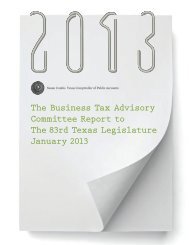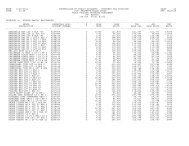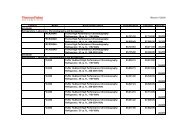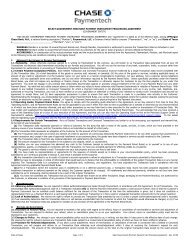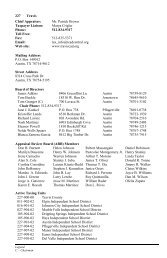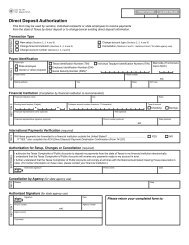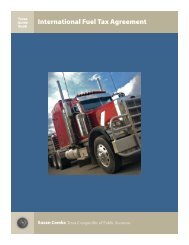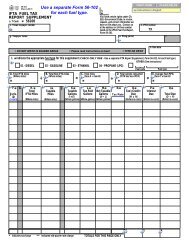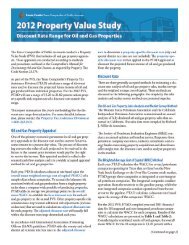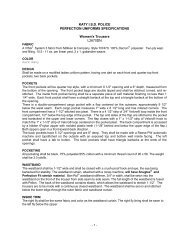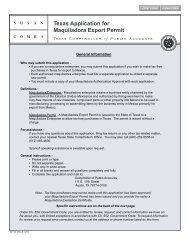Instructions for completing franchise tax reports originally due
Instructions for completing franchise tax reports originally due
Instructions for completing franchise tax reports originally due
Create successful ePaper yourself
Turn your PDF publications into a flip-book with our unique Google optimized e-Paper software.
Form 05-364-3 (Rev.5-07/10)Box 3 Blacken this box if the corporation is a close corporationthat has 35 or fewer shareholders.Box 4 Blacken this box if the corporation is an S corporation.ITEM 1 - INITIAL REPORTS: If the corporation is the survivorof a merger which occurred between the date entered in Item 2(see instructions) and January 1 of the year in which this reportis <strong>due</strong>, the corporation owes <strong>tax</strong> on net <strong>tax</strong>able capital based onits financial condition as of the day after the date of the merger.The corporation should check “YES” in Item 1 and enter the dayafter the date of merger in Item 2. The new <strong>due</strong> date is 91 daysafter the date of the merger, if that date is after the original <strong>due</strong>date.ANNUAL REPORTS: If the corporation is the survivor of amerger which occurred between the end of its last accountingperiod in the year prior to this report year and January 1 of thisreport year, the corporation owes <strong>tax</strong> on net <strong>tax</strong>able capitalbased on its financial condition as of the day after the date ofmerger. The corporation should check “YES” in Item 1 andenter the day after the date of merger in Item 2.ITEM 2 - INITIAL REPORTS: Enter the last accountingperiod ending date that is at least six months after thebeginning date and at least 60 days be<strong>for</strong>e the original <strong>due</strong> dateof the initial report.Example 1: The corporation’s last normal accounting periodending date is 12-31-02. The corporation’s beginning date inTexas is 04-03-02. The original <strong>due</strong> date of its initial report is07-01-03. Six months from the corporation’s beginning datewould be 10-03-02. Sixty days be<strong>for</strong>e the corporation’s original<strong>due</strong> date would be 05-02-03. The normal accounting periodending date of 12-31-02 falls between the period of 10-03-02and 05-02-03. There<strong>for</strong>e, the corporation must use its lastnormal accounting period ending date of 12-31-02.If the corporation’s normal accounting period ending date doesnot fall between six months after the beginning date and atleast 60 days prior to the original <strong>due</strong> date, then enter the endof the month that is closest to the first anniversary of thebeginning date.Example 2: The corporation’s last normal accounting periodending date is 09-30-02. The corporation’s beginning date inTexas is 04-03-02. The original <strong>due</strong> date of its initial report is07-01-03. 09-30-02 does not fall between six months after thebeginning date and 60 days prior to the <strong>due</strong> date. There<strong>for</strong>e, thecorporation must use accounting in<strong>for</strong>mation as of 03-31-03.ANNUAL REPORTS: Enter the date of the corporation’s lastaccounting period ending in the calendar year prior to thereport year.Example 3: Report year 2003; corporation’s last accountingperiod ending date - January 31. Corporation should use01-31-02 to file the 2003 report.ITEM 3 - A corporation with zero Texas receipts on ScheduleA will have a zero apportionment factor <strong>for</strong> <strong>tax</strong>able capital andwill owe no <strong>tax</strong> on Schedule A. The survivor of a mergershould combine its receipts and the receipts of the nonsurvivors<strong>for</strong> the same accounting period used by the survivor.Gross receipts <strong>for</strong> <strong>tax</strong>able capital means all revenues that wouldbe recognized annually under a GAAP method of accounting,without deduction <strong>for</strong> the cost of property sold, or other costsincurred, unless otherwise provided <strong>for</strong> by law. Initial filersshould use gross receipts from the first date of doing businessthrough the month ending date used on line 2. Annual filersshould use 12 months of gross receipts based on the lastaccounting year-end date.Gross receipts in Texas include:· sales of real property located in Texas, including royaltiesfrom oil, gas, or other mineral interests;· sales of tangible personal property when the property isdelivered or shipped to a purchaser within Texas;· sales of tangible personal property when the property isshipped from Texas to a state in which the corporation isnot subject to <strong>tax</strong>ation (the “throwback rule”);· services per<strong>for</strong>med within Texas;· rentals of property situated in Texas;· royalties from use of patents or copyrights within Texas;· revenues from the use of trademarks, <strong>franchise</strong>s, or licenseswithin Texas, effective <strong>for</strong> <strong>reports</strong> <strong>originally</strong> <strong>due</strong> on or afterJanuary 1, 1998. For <strong>reports</strong> that are <strong>originally</strong> <strong>due</strong> prior toJanuary 1, 1998, these revenues are apportioned to thelocation of payor. These revenues do not include receiptsfrom the sale or license of computer software or programs,which are apportioned to the legal domicile of the payor;· the net gain from the sales of investments or capital assets(See definition in Item 4). A net loss is treated as zeroreceipts. If the combination of net gains and losses resultsin a net gain and both Texas and non-Texas sales haveoccurred, a separate calculation of net gains and losses onTexas sales must be made. Sales of intangibles held ascapital assets or investments (e.g., stocks, bonds, goodwill,patents, trademarks, partnership interests, etc.) tocorporations incorporated in Texas are gross receipts inTexas. If the Texas net gain is greater than the total netgain, the Texas net gain to report equals the total net gain;and· all other business receipts within Texas includingdividends as of the date declared and interest from Texaspayors. For example, dividends received from acorporation incorporated in Texas are Texas receipts.BANKING CORPORATIONS & SAVINGS AND LOANASSOCIATIONS - For <strong>reports</strong> <strong>originally</strong> <strong>due</strong> be<strong>for</strong>e January 1,2000, dividends and interest received by a banking corporationor savings and loan association are Texas receipts if thebanking corporation or savings and loan association has itscommercial domicile in Texas. For <strong>reports</strong> <strong>originally</strong> <strong>due</strong> on orafter January 1, 2000, dividends and interest received by abanking corporation or savings and loan association are Texasreceipts if they are paid by a corporation incorporated in Texasor, if they are paid by an entity or person legally domiciled inTexas. For <strong>reports</strong> <strong>originally</strong> <strong>due</strong> on or after January 1, 2002, abanking corporation should exclude from its Texas receiptsinterest earned on federal funds and interest earned onsecurities sold under an agreement to repurchase that are heldin a correspondent bank domiciled in Texas.ITEM 4 - Gross receipts everywhere include:· all sales of tangible personal property;· all rentals;· all services;· all royalties;· all other business receipts;· all dividends as of the date declared and interest; and· the net gain from the sales of investments or capital assets.A net loss is treated as zero receipts. A capital asset is anyasset, other than an investment, which is held <strong>for</strong> use in theproduction of income, and is subject to depreciation,depletion or amortization. An investment is any non-cashasset not a capital asset and not held as inventory orproceeds from the sale of inventory.



